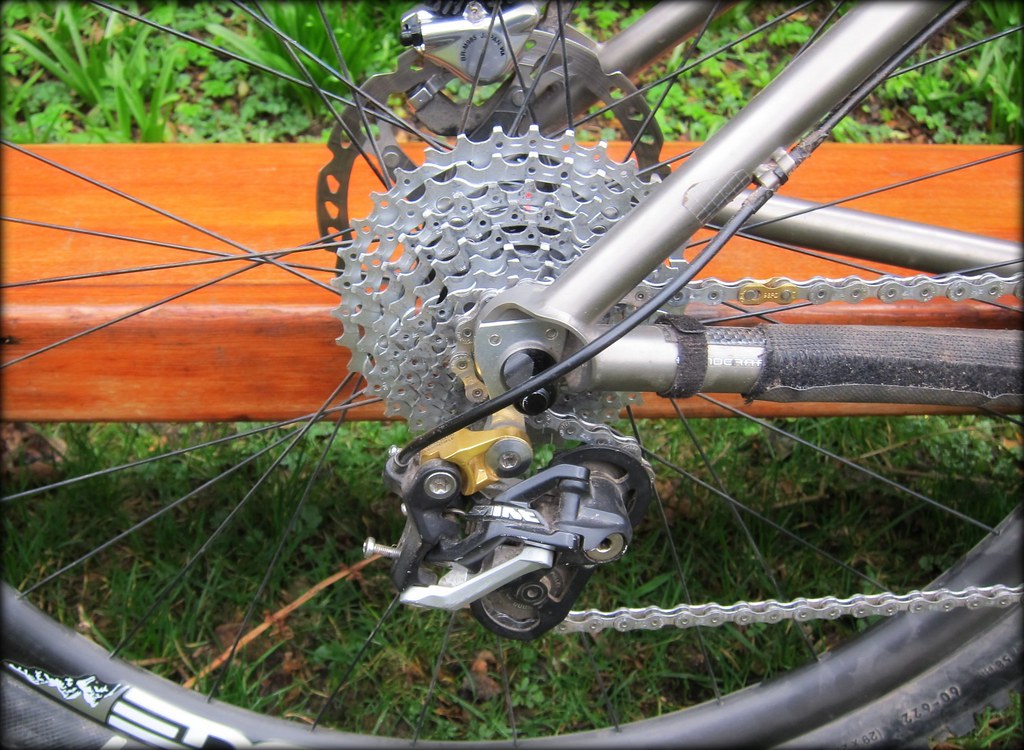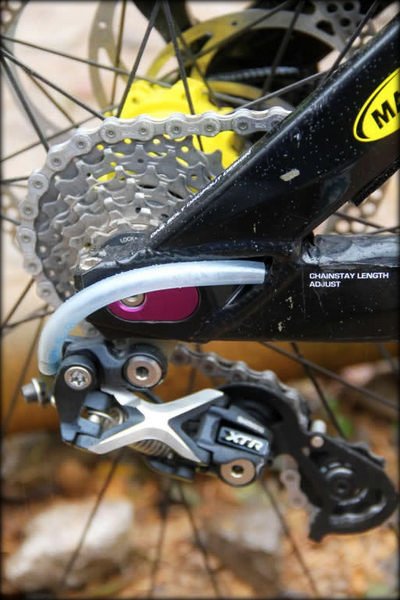I’ve been riding singlespeeds for a long time now, and I’ve ridden a lot of different terrain. Depending on my strength and weight and, admittedly, course profile - I have found anywhere between 34:18 on a 29er to 34:20 being appropriate. But let’s face it, it is a compromise. At present I have settled pretty much on 33:18 which gives me a development of 167”.
When I went to a 6 speed, albeit on a slightly heavier bike, I ended up using a 40 tooth chainring with a cut down 17-34 cassette. The ratios left were 40:17/20/23/26/30/34 giving a development of 214.4”/182.2”/158.4”/140.2”/121.5”/107.2” which is a pretty good spread. Ideally you want to spend most of the time in the middle 3 or so cogs right? So the chainline is straight and therefore efficient and you get the quickest changes with the least aggravation.
You will notice that on that spread, I was going to be riding high in the block and the ratio’s weren’t ideal given what I was used to spinning (well, ok, pushing in squares). Most of the time, I felt I was in a slightly ‘wrong’ gear.

So what? …change the chainring or the block… well, not as easy as all that. To get the cogs on an alloy carrier to fit on a singlespeed freehub body (as was on the DT hub I was using on BA) I was limited to a pretty small possible selection of cassettes. In addition, to make having gears on the bike worthwhile, I needed to try and keep the range useful. As it was, I was often using the highest gear, and occasionally needing the lowest, so I didn’t want to decrease the range from the 40x17-34. Along with the fact that 9/10 speed DT 150mm rear hubs are dishless, and I wanted a stiffer stronger rim (reducing the need for super wide flange spacng at the hub), I knew I could move to a 1x9 or 1x10 and retain the range, or even improve it, but give myself better gears around the sweet spot.
Initially I did some calculations and worked out that a 35 tooth ring and an 11-34 spread would give me an ample and good enough range.
Development with the 35 tooth ring and 11-34 cassette: 289.9”/245.3”/212.8”/187.6”/159.4”/138.6”/122.6”/106.3”/93.8”
Oddly, it didn’t feel right straight from the off….again I was never in the right gear as much as I wanted to be. You’ll notice the middle ratios dance around the 167” I am most used to pedalling…but not close enough to feel comfortable? Seems far fetched, but so it was.
However, no matter. In this situation it was easy to pop on a 36 tooth ring which, with the 11-34 cassette, gives.
298.2”/252.3”/218.7”/192.9”/164”/142.6”/126.1”/109.3”/98.5”.
Still an excellent spread and the middle ratio is 164” – really close to my ‘ideal’.
But – I hear you cry – (you are still paying attention, yes?) why not use a smaller chainring with the 11-34, as its quite a lot of high end and the chainline defers to the smaller rear cogs anyway due to the 83mm bb shell right? Or even add a 11-32 block with the smaller chainring?
34 ring with 11-34 cassette gives:
281.6”/238.3”/206.5”/182.2”/154.9”/134.7”/119.1”/103.3”/91.1”
35 ring and 11-32 cassette gives:
289.9”/265.7”/227.8”/199.3”/177.2”/151.8”/132.9”/113.9”/99.6”
34 ring with an 11-32 cassette gives:
281.6”/258.1”/221.3”/193.6”/172.1”/147.5”/129.1”/110.6”/96.8”
33 ring with 11-32 cassette gives:
273.3”/250.5”/214.8”/187.9”/167”/143.2”/125.3”/107.4”/94.0”
Hmmm! The only one that comes close to the magic mid-point gear is the 33x 11-32…but the gears on either side are 187.9” and 143.2” compared to the 192.9” and 142.6” with the 36x11-34, and the latter set up gives more low-end and more high end in a pinch.
So, that probably goes some way to explaining why my 1x9 ratios seem way bigger than what most folk seem to be running. I think, anyway!

This also helps me plan the gearing on the new, xc orientated beast. Clearance here is likely to be tighter, as it's going to have a 73mm shell, but i think i can get a 36 on there, especially as it will be mounted to the outer position of the XTR M980 crank. I'll probably stick with 9 speeds, as it will allow me to use a saint rear derailleur, or perhaps an xtr/saint splice a la fabien barel? (as pictured above). We'll see.
More Mountain Biking Videos
5 comments:
Hi Jon, I've been reading your blog for quite a while, now, and really enjoy it. But sometimes, when you post up something like this, I can't help but feel that you're thinking about things a little too much!
probably true!....i could have summarised by saying "odd how the ratios werent feeling right, made a change, much better."
i guess i just wanted to know why it didnt feel right!....
the other thing is i tend to use my blog to sort of keep track of things i work out/dwell on so i can easily find them in the future.....
thanks for enjoying :-)~
I suggest you calculate the a problem shared is a problem multiplied ratio for your blog posts. You could tell me that I don't have to read it but I do - you're part of my research.
All those #s hurt my wee little brain.
Oh. My. God.
You've finally becomes *exactly* as anal about gears as some of us feared. That's why we need you to stick to singlespeeds j0n.*
I also wondered what the hell gears you were pushing until I worked out that you'd bothered multiplying by pi. You're the first person in the bike world I've ever come across that does that. Most people just multiply gear ratio by nominal wheel diameter, so my 32:16 = 52 inches, but for you it would be 58 inches.
If you're that bothered about accurate gear development you're also going to have to take into account tyre width, rim profile, tyre profile, tyre pressure... They don't allow you to adjust cycle computers by the mm for nothing!
* and this comes from someone that used to ride with a table of the gear inches for his particular crankset/sprocket combo taped to their stem so they could make best use of inner and outer cogs to reduce the difference between succesive gear changes.
Post a Comment